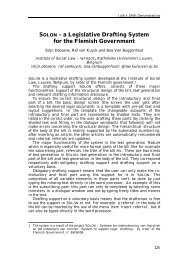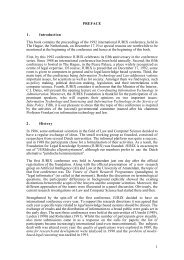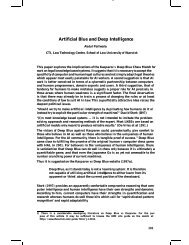On automatic causal reasoning for legal analysis - Jurix
On automatic causal reasoning for legal analysis - Jurix
On automatic causal reasoning for legal analysis - Jurix
Create successful ePaper yourself
Turn your PDF publications into a flip-book with our unique Google optimized e-Paper software.
explaining FODVVHV of events! Hence, Hart and Honoré propose a <strong>causal</strong> inference scheme,<br />
based on a wide <strong>analysis</strong> of <strong>legal</strong> <strong>causal</strong> language in a (non arbitrary) selection of cases.<br />
7DEOH The identification of events <strong>for</strong> Case 1<br />
Event’s Name Process Object Time Actor<br />
e1 selling rifle t1 defendant (D)<br />
e2 ordering boy t2 mother (M)<br />
e3 refusing boy t3 Defendant<br />
e4 hiding rifle t4 Mother<br />
e5 finding rifle t5 boy (B)<br />
e6 allowing mate t6 Boy<br />
e7 shooting bullet t7 playmate (P)<br />
e8 wounding plaintiff t8<br />
They see their proposal as a guideline <strong>for</strong> an aware use of <strong>causal</strong> <strong>reasoning</strong> by the court; they<br />
think of it as a moderate way of bridging the gap between the two extreme interpretations of<br />
the judicial viewpoint. The two English scholars provide the following definition.<br />
'HILQLWLRQ: Agent $ causes an event H, that might involve agent % if either:<br />
1. $ starts someSK\VLFDO SURFHVV that leads to H;<br />
2. $ provides UHDVRQV or draws attention to reasons which might influence the conduct<br />
of %, who causes H;<br />
3. $ provides % with RSSRUWXQLWLHV <strong>for</strong> doing things that will lead % to cause H.<br />
All three types of causation “have important negative variants.”(in [5], p.3). For illustrative<br />
purposes Definition 2 is here applied to the Case. By doing this the virtues and the vices of<br />
Hart and Honoré’s proposal are made clearer both at the modeling and at the inferential level.<br />
To model the Case, first, chop up the story into a temporal sequence of events as in Table 1.<br />
The two English author do not provide an explicit specification of what they mean by<br />
event. There<strong>for</strong>e <strong>for</strong> the moment we use a widely acceptable ontology of event based on<br />
objects and processes Second, “immerse” the events into the space of preconditions (i.e., a<br />
conceptual space where every event is a precondition of all the successive events represented<br />
by the box in Figure 2), ordering them by actor and time. Third, make an inferential step: <strong>for</strong><br />
each event control if it can be considered as a cause of any successive event according to Hart<br />
and Honoré’s test. Roughly speaking, such assessment consists in establishing whether the<br />
process of the precondition “leads” (physically of psychologically) to the object of the<br />
postcondition. In our example, the resulting graph might look as Figure 2.<br />
In the intention of Hart and Honoré, a <strong>causal</strong> reconstruction in terms of physical<br />
processes, reasons and opportunities should clarify the material development of events and,<br />
there<strong>for</strong>e, help in applying <strong>legal</strong> principles. In other words, it could be a good way of<br />
focusing the attention of the <strong>legal</strong> expert on those parts of the case that are particularly<br />
relevant <strong>for</strong> determining responsibility. <strong>On</strong> the other hand, the model leaves a lot of unsolved<br />
ambiguities. These ambiguities are intentionally left unsolved by Hart and Honoré; because,<br />
as explained, the scheme they propose should only work as a guideline in <strong>legal</strong> <strong>analysis</strong>, not<br />
as a set of rigid rules directly applicable to every case. It is hence the practitioner’s job to<br />
resolve the uncertainties in the meaning of the terms in the scheme, every time this is applied.<br />
But <strong>for</strong> the purpose of automation a more precise definition of the notions used in the scheme<br />
must be provided.






